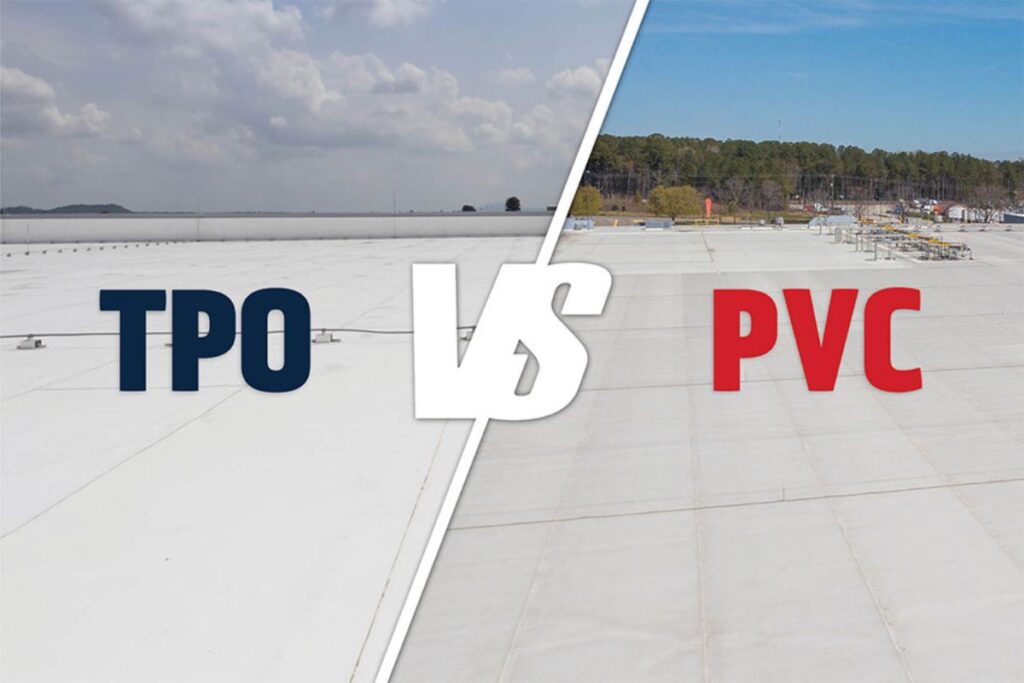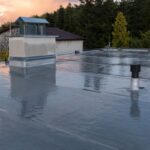When choosing a roofing system for your commercial building, you have many options. Two popular materials are TPO (Thermoplastic Polyolefin) and PVC (Polyvinyl Chloride). These single-ply membranes are great for flat or low-slope roofs. They are durable, energy-efficient, and low maintenance.
Which one should you pick for your next roofing project? This article will break it down simply. We’ll discuss costs, durability, performance, and environmental impact.
Let’s get started.
What Is TPO Roofing?
TPO is a type of single-ply roofing membrane that’s made from a blend of rubber and plastic. It’s known for being a cost-effective, reflective, and eco-friendly roofing solution.
Key Benefits of TPO:
-
Affordable: One of the most budget-friendly commercial roofing systems.
-
Reflective surface: Helps reduce cooling costs by reflecting UV rays.
-
Resistant: Protects against tears, punctures, and UV damage.
-
Environmentally friendly: It’s 100% recyclable and has a lower carbon footprint.
What Is PVC Roofing?
PVC roofing has been around a lot longer than TPO. It’s made from polyvinyl chloride and offers excellent strength, flexibility, and resistance to chemicals. It’s especially popular in industries where oils and greases are involved.
Key Benefits of PVC:
-
Durable: Stands up to extreme conditions like heavy winds, rain, and chemicals.
-
Fire-resistant: Self-extinguishing in case of fire.
-
Low maintenance: Longer lifespan with fewer repairs.
-
Chemical-resistant: Great for restaurants, factories, and labs.
TPO vs. PVC Roofing: Key Differences
Now let’s dive deeper and compare the two side by side. Here are 6 major differences to consider:
1. Durability
-
TPO is tough and performs well under normal weather conditions. It resists UV rays and punctures, but in extremely hot or chemical-heavy environments, it may not last as long.
-
PVC is more durable overall. It holds up better in tough environments like manufacturing plants or hot, humid climates.
Winner: PVC, especially in extreme conditions.
2. Cost
-
TPO is usually cheaper to install. This makes it appealing for those who want a good roof without a big upfront investment.
-
PVC costs more upfront, but because it lasts longer and needs fewer repairs, it may save money in the long run.
Winner: TPO for short-term budgets, PVC for long-term savings.
3. Energy Efficiency
Both TPO and PVC are good at reflecting sunlight, which helps reduce your building’s cooling costs.
-
TPO typically comes in white and has higher reflectivity.
-
PVC also reflects heat, just slightly less than TPO.
Winner: Slight edge to TPO for energy savings.
4. Chemical Resistance
This is a big one if your building handles grease, oils, or chemicals.
-
TPO is fine for general use but can break down if exposed to harsh substances over time.
-
PVC is highly resistant to chemicals, which is why it’s often used on restaurants and industrial roofs.
Winner: PVC, hands down.
5. Ease of Installation
-
TPO is lightweight and flexible, so it’s easier to install and can be done quickly. That also helps reduce labor costs.
-
PVC is a bit heavier and takes more time, but experienced contractors can still install it efficiently.
Winner: TPO for faster, easier installs.
6. Environmental Impact
If you’re looking for a more eco-friendly option:
-
TPO is 100% recyclable and has a less harmful manufacturing process.
-
PVC can be harder to recycle and its production process has more environmental impact.
Winner: TPO for sustainability.
Read More: How Much Does Tar and Gravel Roof Cost in 2025?
What Factors Should You Consider?
Before making a decision between TPO and PVC roofing, take a look at these five key factors:
1. Budget
If you’re working with a limited budget, TPO is going to give you solid performance for a lower upfront cost. If you can afford to spend more upfront for something longer-lasting, PVC may be the better investment.
2. Type of Building
What kind of building are you roofing?
-
TPO is great for warehouses, office buildings, and retail stores.
-
PVC is ideal for restaurants, industrial sites, or any place where the roof is exposed to chemicals or grease.
3. Local Climate
If you live in a hot, sunny area, TPO may perform better thanks to its superior reflectivity. In areas with extreme weather (like storms or high winds), PVC is the stronger choice.
4. Environmental Goals
Want to go green? TPO is the winner here with its recyclable materials and energy-saving design.
5. Contractor Experience
No matter which material you pick, make sure your roofing contractor is experienced with that specific system. Poor installation is one of the main reasons roofs fail early—especially with TPO, which can vary in quality between manufacturers.
Summary: TPO vs PVC Roofing
| Feature | TPO | PVC |
|---|---|---|
| Cost | Lower upfront | Higher upfront, better long-term value |
| Durability | Good | Excellent |
| Chemical Resistance | Limited | Excellent |
| Energy Efficiency | Excellent | Very Good |
| Environmental Impact | Eco-friendly | Less eco-friendly |
| Installation | Easier, faster | More labor-intensive |
Final Thoughts
TPO is great for a budget-friendly, energy-efficient roof, especially if your building isn’t exposed to chemicals. PVC is a better choice for durability and longevity, especially in tough environments.
It’s not about which is best overall—it’s about what suits your specific building.
At GreenTek Roofing & Solar, we’ve installed TPO and PVC roofing systems on various commercial properties in the Tampa Bay area. Whether you care about cost, durability, or sustainability, we help you choose based on your needs.
As GAF Master Elite and TAMKO Pro Certified contractors, we provide more than options—we deliver trusted results.



